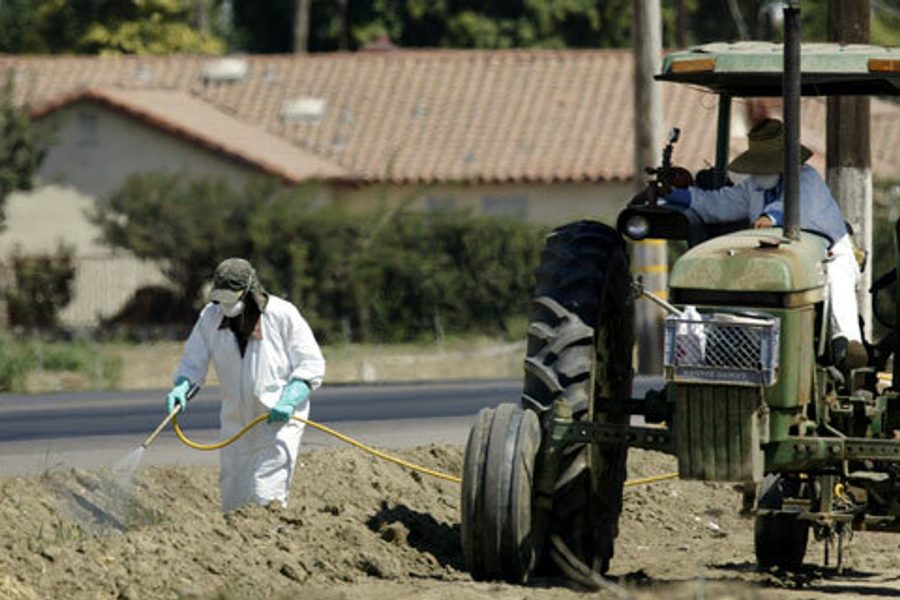
Calif. Gov. Jerry Brown’s veto of card check legislation underscores the priorities of the powerful
Shortly after the group of Mexican “guestworkers” arrived at a Tennessee tomato farm, they realized that their job was killing them, literally. In addition to being crowded into filthy trailers with no source of clean water, they and their living quarters were regularly showered with poison. Despite requirements for protective equipment, they had to go into the fields while exposed to pesticides. Risking abuse and retaliation for challenging their boss, some tried to use cellphones to record the spraying. In the end, they got their evidence, but then got fired.
The workers’ struggle, which led to a lawsuit filed earlier this year, illustrates all the paradoxes of America’s natural bounty. No form of labor is more ingrained in humanity than farm work, but the people who grow our food are being eaten alive every day by the toxins of modern industrial farming. Though consumers are more anxious than ever these days about the effects of pesticides on the food we eat, they seldom consider the health hazards facing the workers who feed our consumption. Yet the further you get up the production chain, the greater the danger.
Farmworker Justice has petitioned the Environmental Protection Agency to demand the bilingual labeling of pesticides for Spanish-speaking workers, many of whom cannot read English. The fact that after generations of importing migrant labor even this most rudimentary safeguard is still lacking, shows how little the government and employers value workers’ health.
We should all know better by now. Various studies, including a new one on Monsanto’s infamous Roundup Ready, have shown major threats from the chemicals sprayed on crops. In the Lake Apopka area of Florida, exposure of black farm workers to pesticides has been linked to horrific patterns of disease and birth defects, on top of the backbreaking labor they suffered. Their attempts at seeking legal redress have so far failed.
One monitoring project in Washington State, published by the Farm Worker Pesticide Project, found that one in five workers surveyed suffered “significant nervous system impacts.” The health risks were exacerbated by incompetent enforcement of safety standards at the federal and state levels, and threadbare regulations on protective gear for farmworkers. Finally, there was an endemic failure to promote safe alternatives to the harmful chemicals used in industrial agriculture.
The politics of the food system therefore disproportionately impact farm workers (including a huge number of families with children), yet they have virtually no political power, and don’t have the option of selecting just organic fruit when they’re working the farms in a chemical haze.
The consumer advocacy organization Environmental Working Group (EWG) published its “Dirty Dozen” list of chemical-laden produce, but it doesn’t get at the core of the problem, according to Tom Philpott at MoJo:
My only concern about campaigns like EWG’s Dirty Dozen is that they keep the spotlight on consumers and off of another population segment that deserves protection from the produce industry’s pesticide habit: farm workers….
The agrichemical industry’s response — embraced by farm owners, government regulators, and global aid institutions — was to promote pesticides that break down rapidly. But these alternatives, known as “non-persistent” chemicals, are much more dangerous at the time of application. That is to say, they’re much safer for consumers, and much more dangerous for farm workers.
In fact, such dangerous working conditions are encouraged by our food system and regulatory infrastructure.
This week, a bill in California to enable card-check voting on farms, which would facilitate union organizing, was vetoed by Democratic Gov. Jerry Brown, who while governor in the 1970s signed legislation giving farmworkers in his state the right to unionize through secret ballot. The defeat suggested that the loyalties of even supposedly “progressive” politicians lie more with powerful business lobbies than with voiceless farm workers. The consequences ultimately wind up on our dinner tables.
Karl Tupper with the Pesticide Action Network of North America, takes pesticide concerns from the grocery aisle to the larger context:
My point is two-fold. 1) The scandal isn’t cilantro, or apples. It’s 2 million people doing the third most dangerous job in the country for sub-poverty wages, while facing pesticide exposure. 2) We can’t shop our way out of this: pesticides are a public policy issue.
Currently, it’s private and grassroots efforts that are breaking ground in environmental justice for farmworkers. Along with labor-based groups like Farmworker Justice and United Farm Workers, grassroots movements like the Coalition of Imokalee Workers have raised public awareness of agricultural labor conditions and the link to public health as well as corporate power.
In Washington, the pioneering Excluded Workers Congress is pushing the POWER Act, which would aim to “protect the right of immigrant workers to expose labor violations without fear of retaliation” by boosting regulatory safeguards and legal protections for exploited immigrants.
Groups like the Pesticide Action Network and Beyond Pesticides have mobilized consumers and workers across the planet to push for a safer food system. And all the way over in Pakistan, an international campaign known as the Better Cotton Initiative seeks to introduce more sustainable growing practices to the country’s cotton fields, moving farmers away from pesticides and improving community health.
It’s odd that, even as we ruin our natural resources, Americans still hold romantic visions of the heroic farmer; perhaps it’s our natural yearning to connect with earth despite modern society’s alienation from our ecological genesis. To truly understand environmental health, then, we must think broadly about environmental justice. Locally and globally, from seed to stomach, we are all what we eat.
Michelle Chen is a contributing writer at In These Times and The Nation, a contributing editor at Dissent and a co-producer of the “Belabored” podcast. She studies history at the CUNY Graduate Center. She tweets at @meeshellchen.








